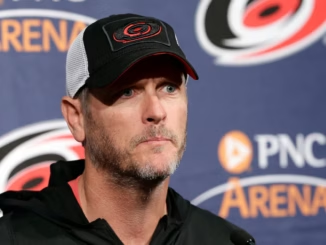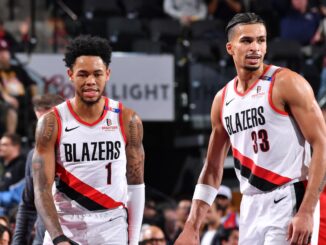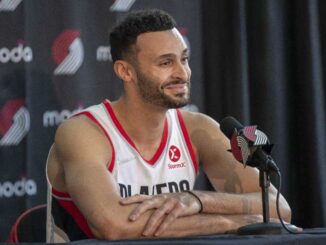
The year was 2017. THEY were once again sleeping on the Portland Trail Blazers.
The Blazers ended up with 48 wins and the third seed in the brutal Western Conference, shutting down critics and keyboard warriors alike. Until…
Jrue Holiday happened.
The Blazers went on to drop the series in 0-4 fashion, but the bad news was just beginning.
The offseason was just as bleh as the first round of the playoffs.
Now we’re just weeks away with more questions than answers as it pertains to the 2018-19 edition of Rip City Season. Jared Wright and Bryant Knox of Oregon Sports News are back with their in-depth Portland Trail Blazers 2017-18 Season Previews for each player.
Today, we take a look at Portland’s $100 million second banana, CJ McCollum.
2017-18 Recap
| Games | MPG | PPG | RPG | APG | FG% | 3PT% | FT% | PER | Turnovers |
| 81 | 36.1 | 21.4 | 4 | 3.4 | 44% | 39.7% | 83% | 17 | 151 |
After three seasons, we can now say that this is your standard McCollum year. We know what to expect from him: 20+ points per game, elite shooting from three, nifty dribbling and superb shot creation for himself, and not much else.
There isn’t a great deal of variance in his production from year-to-year since he replaced Wesley Matthews as the Blazers’ 2-guard, but two things worth pointing out are McCollum’s shooting and his turnovers, and the trends I’ve noticed when looking at his career numbers.
2016-17 was McCollum’s magnum opus in terms of shooting; he nearly joined Larry Bird, Dirk Nowitzki, Stephen Curry, and Kevin Durant as the only players to shoot 50-40-90 (FG%-3PT%-FT%) and average 20 points a game. (Steph is the only guy to do it while averaging 30; Bird averaged 29.9 PPG during one of his 50-40-90 seasons. This was your daily reminder that Stephen Curry is a god among men.) His three-point percentage didn’t have a steep drop-off in 2017-18, only two percentage points, but his overall field-goal percentage dipped from 48% to 44%. CJ also suffered a large regression at the line last year, going from a league-leading 91.2% to 83%, but since he only shot about three free throws per game (and his approach to scoring doesn’t involve seeking contact), it wasn’t really noticed unless he did miss a freebie, which still wasn’t often.
2017-18 might be what the normal is for McCollum shooting-wise as his career progresses. Still very good-to-great, but not among the very best—a skilled mortal trying to scale Olympus only to be kicked back down by Zeus. Might be a metaphor for the Trail Blazers’ last three postseasons, actually.
On a more positive note, McCollum did cut down on his turnovers last season. In fact, his turnover rate has gone steadily down since 2015-16, when he first took over the starting shooting guard spot. CJ has become more comfortable handling the ball in space and is figuring out what passes he can make and not make.
While I personally would want him to create more chances for his teammates (a guy that’s as crafty as McCollum is—and that plays so many minutes with the ball in his hands—should not be averaging less than four assists per game), I admit that the players who surrounded McCollum when he went solo were very uninspiring. If I were him, I’d probably look for my shot all the time, too. Besides, that sweet stepback baseline 15-foot jumper is money; I’d rather see that shot go up than an Evan Turner three-pointer, math be damned.
What He Brings to the Table
We went over most of what McCollum does on the court in the above section, but what he brings off of it is a sort of edginess, a big chip on his shoulder from being overlooked in his amateur days, and a feeling of being underappreciated around the NBA despite the fact that everyone associated with the Association knows he’s a stone-cold killer on the hardwood.
If this also sounds like it describes his more-celebrated teammate, Damian Lillard, you’d be right; their many similarities led to these two proud, stubborn men to become close friends.
Friendship between a team’s top two players is unusual, especially if they play similar positions and/or roles; many a good team has been ripped asunder by internal jealousy and rivalry (looking at you, Kobe and Shaq), but if this era’s Blazers core is going to eventually fail, it won’t be because their best players hate each other.
Being disgruntled and feeling professionally unfulfilled has become a theme lately for McCollum. While Lillard uses Tweets and under-the-table comments to express displeasure over a missed All-Star selection, or complains that the likes of Kyrie Irving and John Wall get more attention than he does, CJ doesn’t waste time with any PR BS and goes straight for the jugular. Lillard finds it tough to make the All-Star Game in the West and might resent it; McCollum doesn’t stand a snowball’s chance in hell of ever being an All-Star and absolutely resents it.
This chippy streak was on full display when Kevin Durant, the second-best player in the world and a key piece of what might be the greatest team of all time, appeared on McCollum’s podcast. Durant is just as brutally honest as McCollum, so some beef was perhaps inevitable. In a back-and-forth between the two, McCollum said that the Blazers were contenders and right there; Durant flatly disagreed and told CJ that the Blazers were also-rans.
Having faced the Blazers first-hand in the postseason on multiple occasions as a Warrior, and having been a big part of dispatching Portland easily in those series, Durant is probably the most-qualified person on the planet not named Anthony Davis to say that about Portland. This didn’t stop McCollum from responding, both on his podcast and on Twitter. Durant also took to Twitter to fire back at McCollum. I’m not all that interested in Tweefs, so I won’t post the history of the Durant-McCollum Tweef here, but both parties said they’ve squashed it.
Durant is a broody guy, though, and isn’t above taking a bit of revenge. When the Golden State Warriors play the Blazers the first time this season, I wouldn’t be surprised if the seven-foot Durant takes the 6’4” McCollum to the rim and dunks on his head.
To sum up, McCollum brings some backbone, some toughness, and frankly, is kind of an a******. That’s OK, though. Every team needs one, and it helps that said a****** can drop 30 on any given night.
What to Expect in 2018-19
We can expect McCollum to continue being a big part of the Blazers offensive attack and to try his damndest on defense (it helps CJ immensely that teams like to target Lillard more on defense). An interesting nugget I dug up while trawling the Internet like a hairy Alaskan fisherman trawls the North Pacific: The Blazers might play Lillard and McCollum together more, and not stagger them so that one is always on the court.
That would probably be disastrous; lineups without both Dame and CJ were predictably slaughtered on the rare occasions coach Terry Stotts utilized them. Portland must really like Seth Curry (aka the Other Curry Brother) to even be thinking about doing this.
In any case, McCollum will continue to shoot, shoot, shoot some more, and when that doesn’t work, shoot. It made him a nine-figure millionaire, after all.
Check out the other players in our Portland Trail Blazers Player Preview Series:




